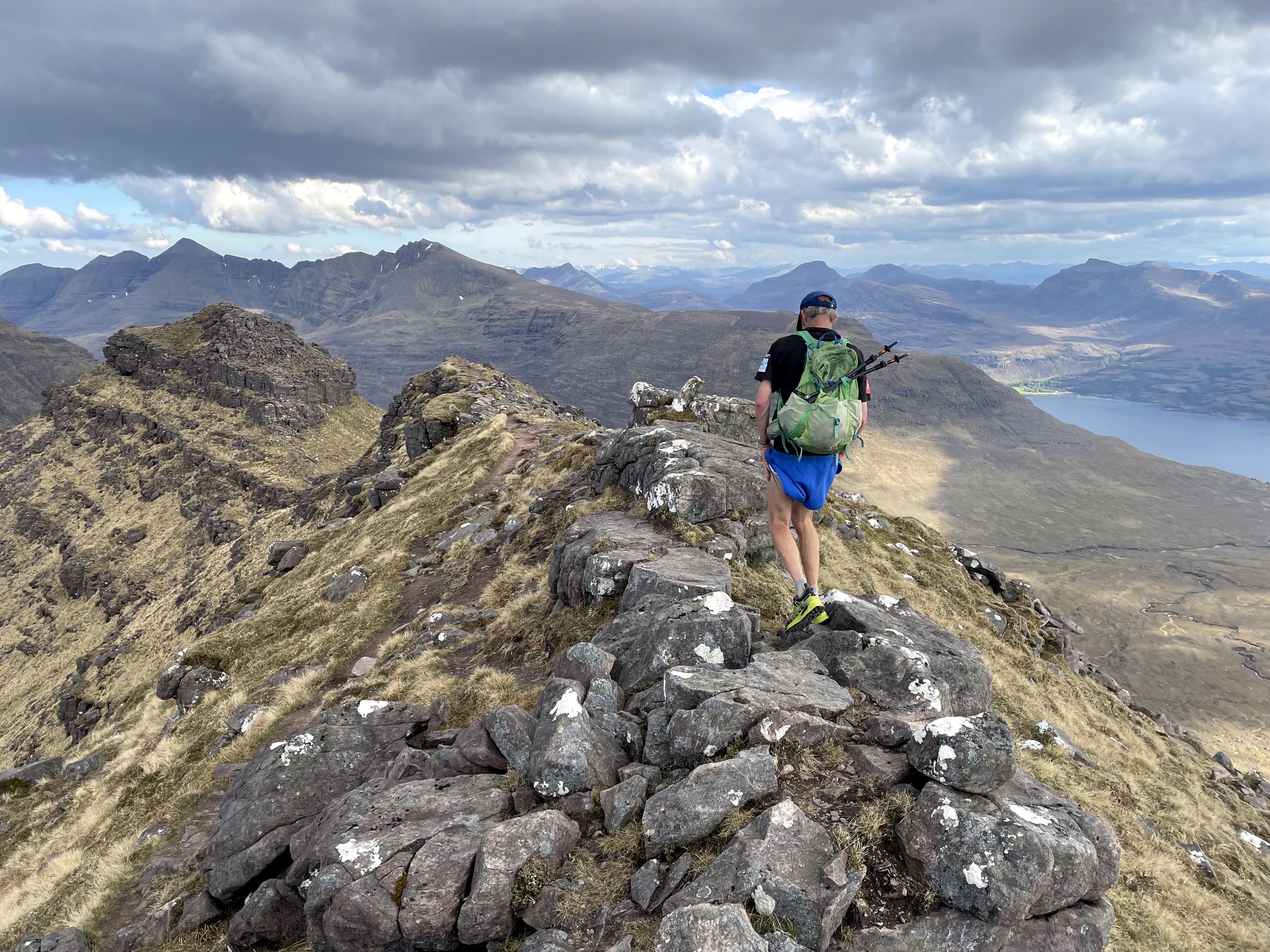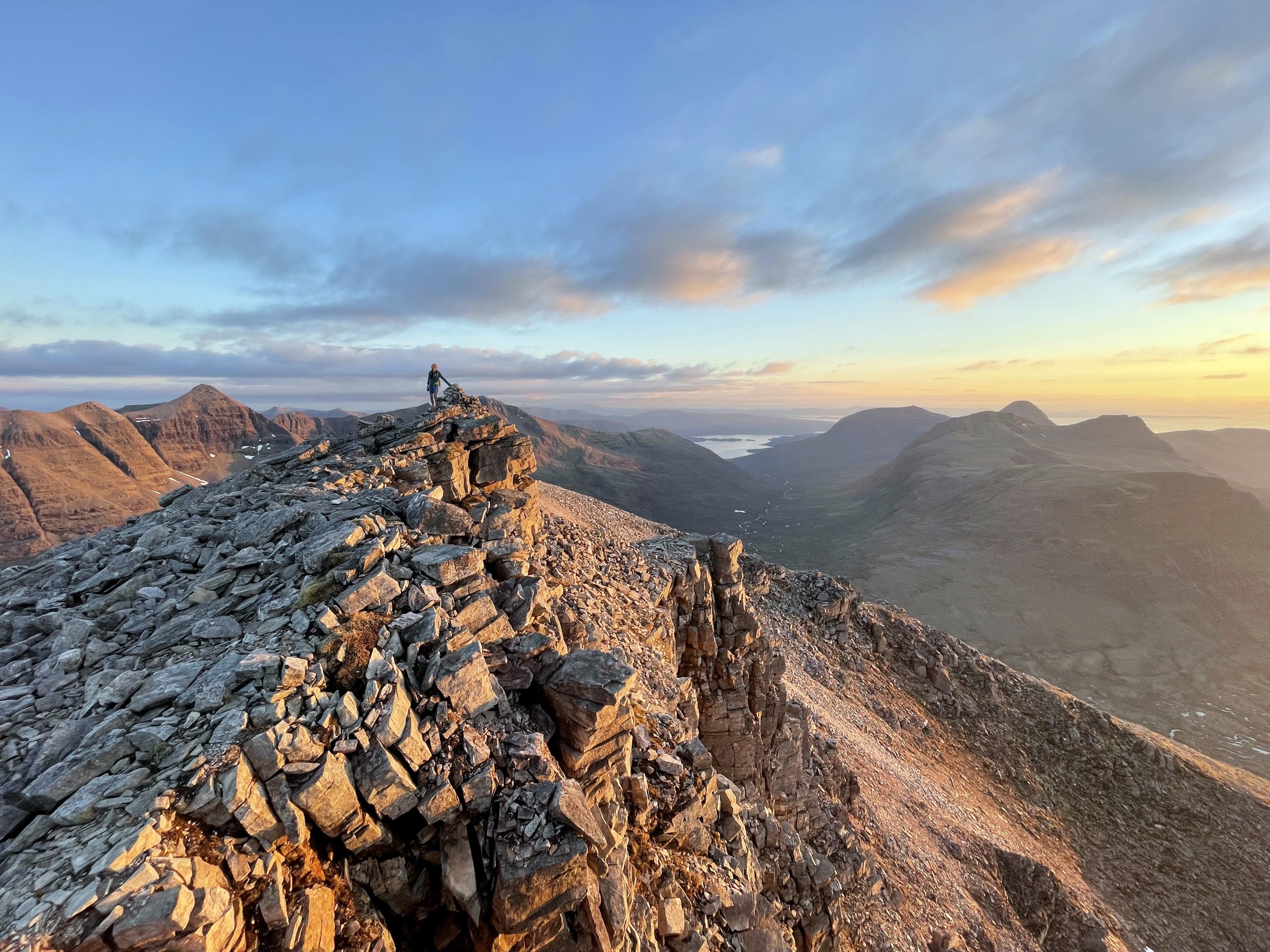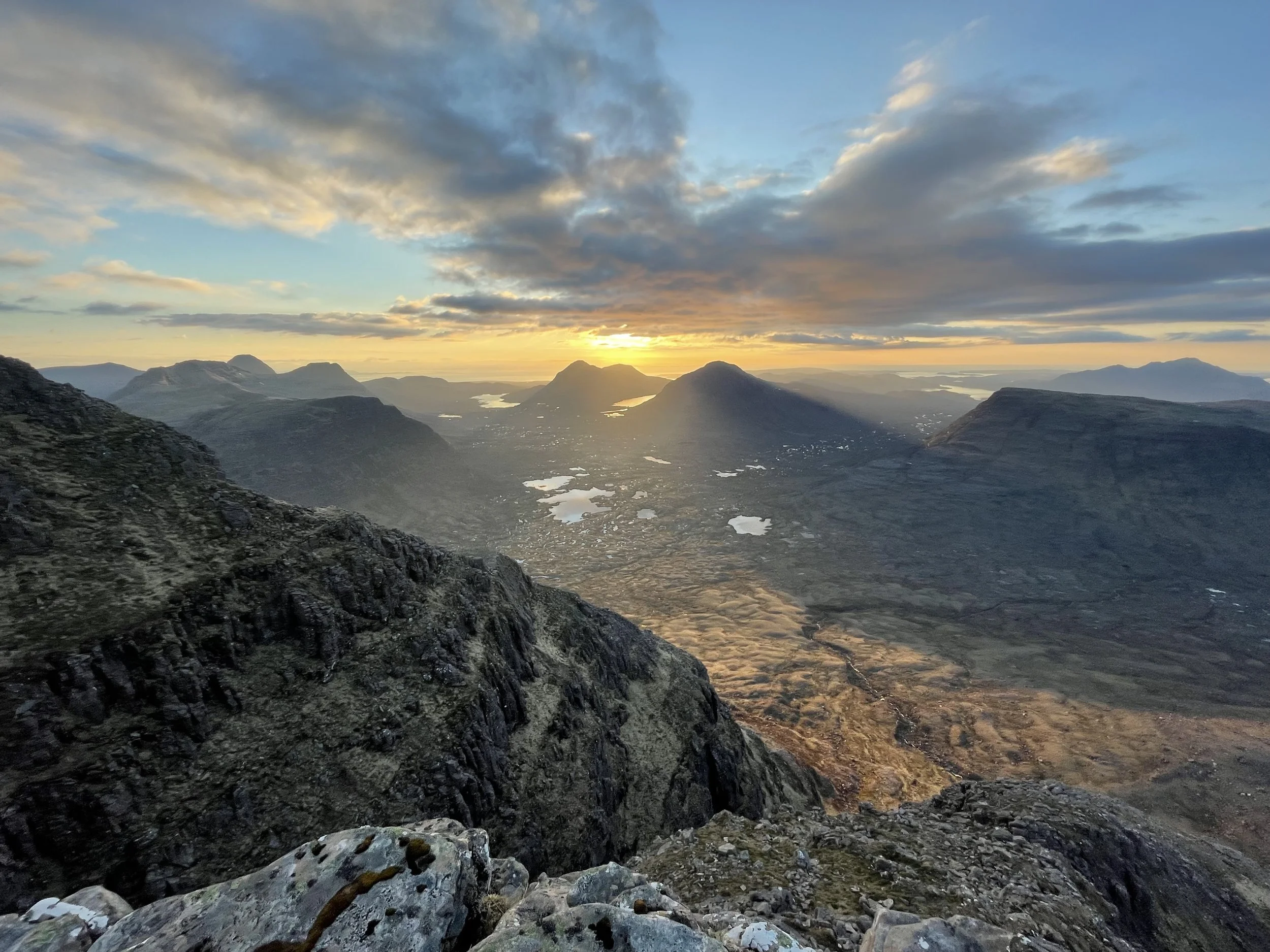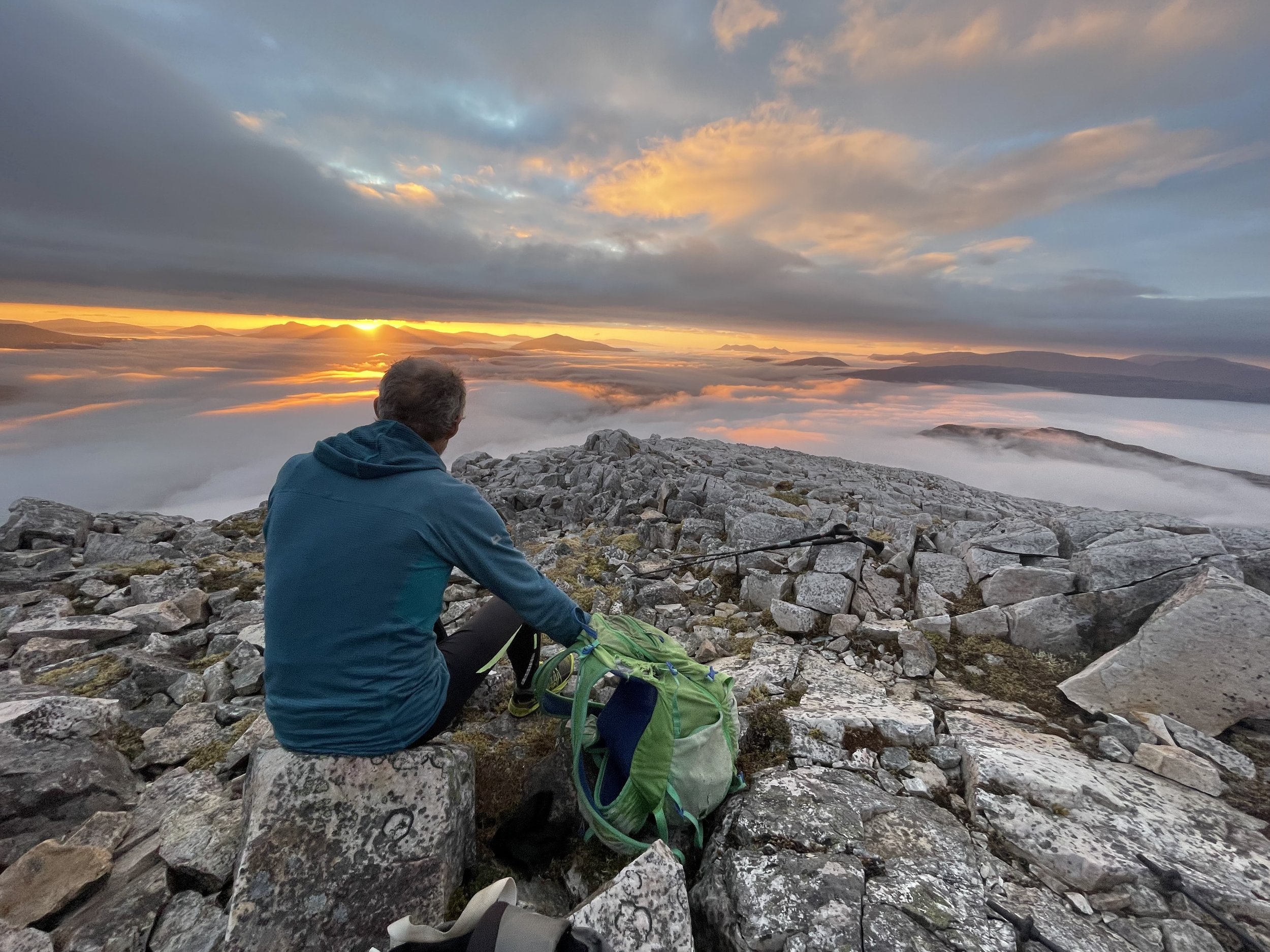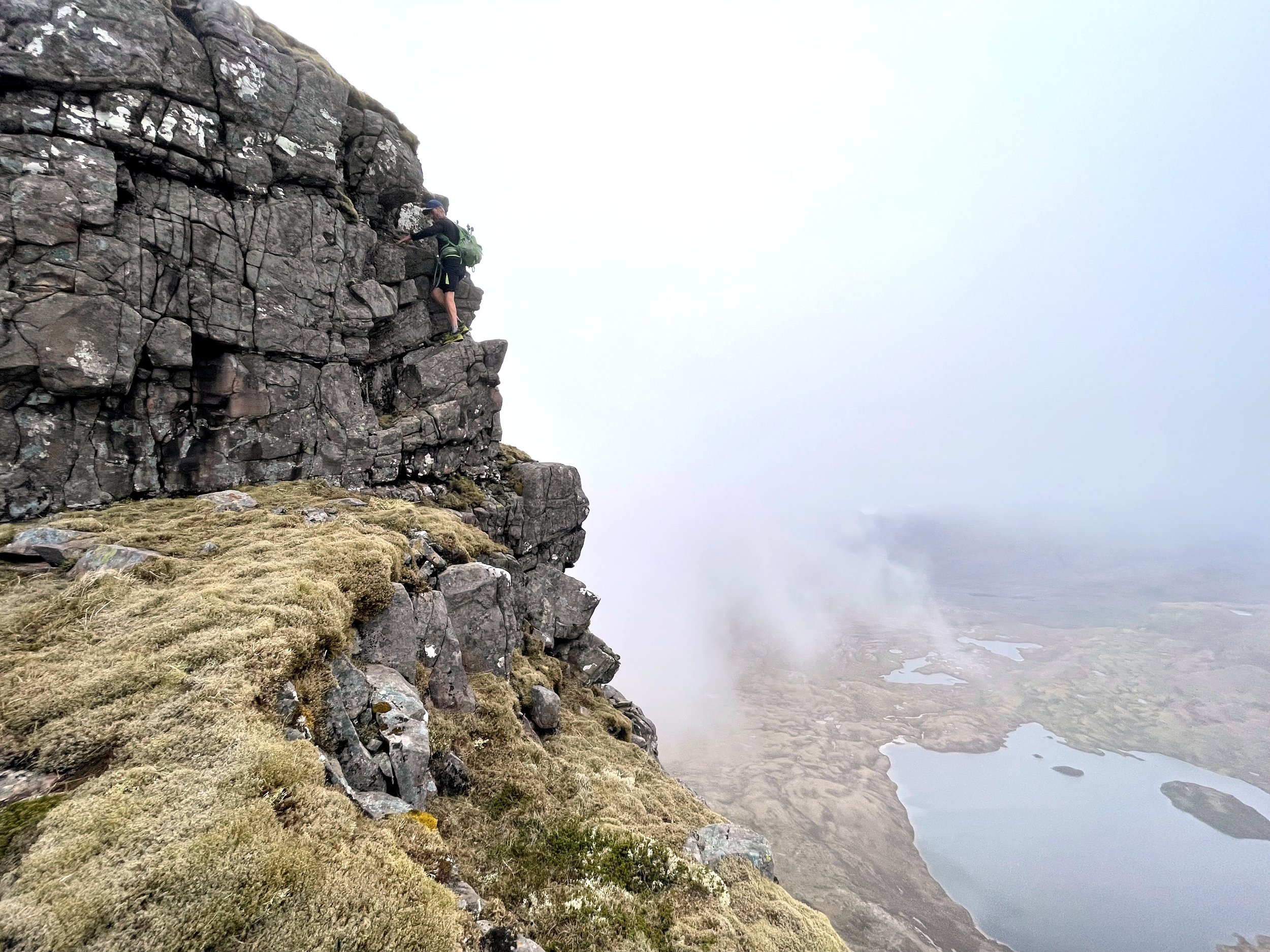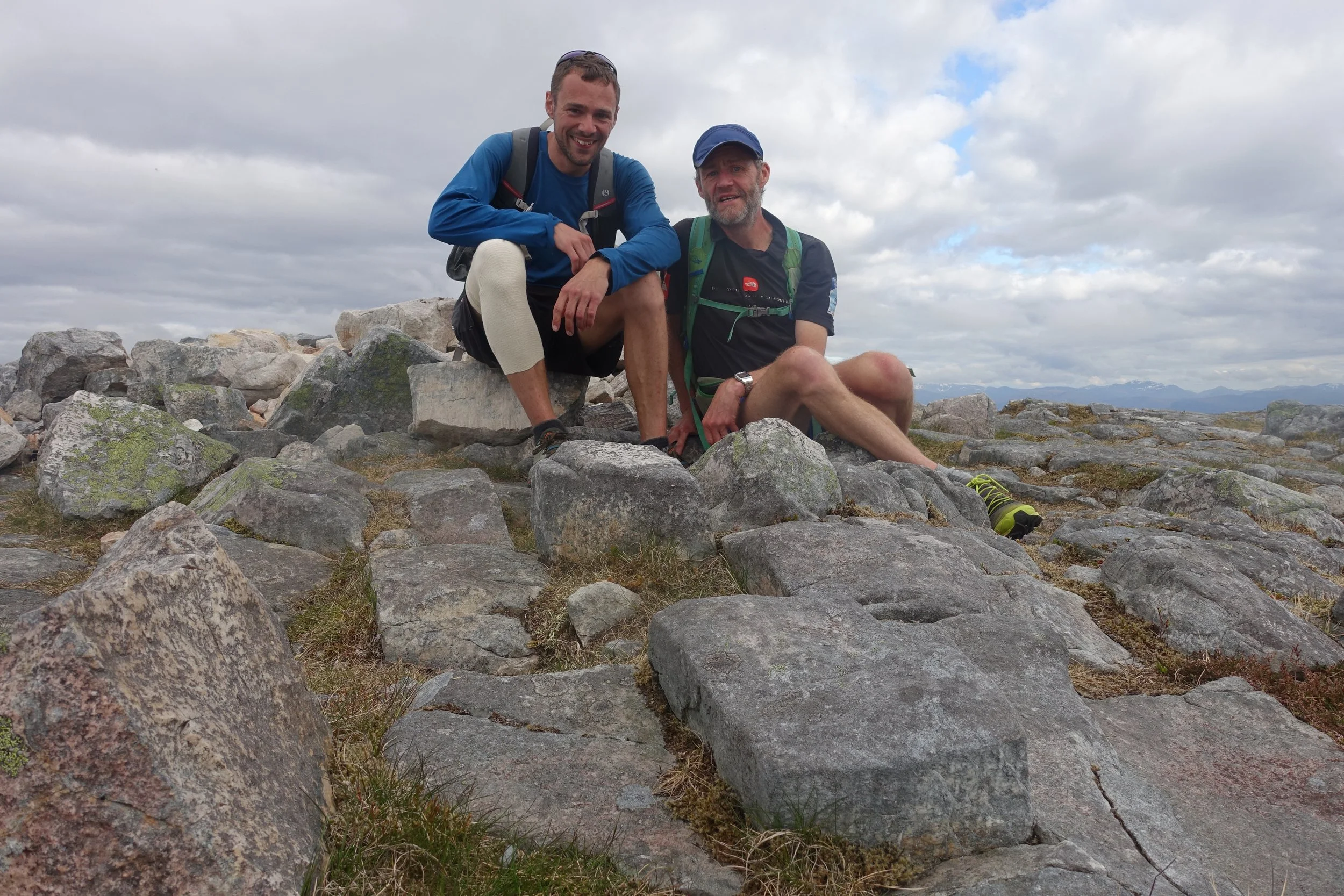
The Long Game
Attempting a non-stop, 72km link-up of scrambles across every hill in Torridon, with over 7000m of ascent.
The Stats:
Distance covered: 72km
Ascent: 7270m
Time Taken: 33 hrs 45 mins
Start/End Point: Torridon Countryside Centre (accessible via bus from Kinlochewe)
Scrambles climbed (grade in brackets):
Liathach Traverse (2)
Tom na Gruagaich Shoulder (1)
Beinn Alligin Traverse (1)
Beinn Dearg (3)
Ling Lawson and Glover's Route (2)
Coinneach Mhor (2)
Maol Chean Dearg North Flank (1/2)
An Ruadh Stac slabs (1/2)
This article first appeared in TGO Magazine.
The thick heather dragged against my knees as we waded up the slopes of Sgurr Dubh in misty, pre-dawn darkness. My friend John and I had been on our feet for over 12 hours and each step in the unending tussocks required more effort and concentration than the last. Tiredness swept across my mind in waves. The sound of John’s ceaseless hiccups had become like the ticking of some strange broken clock that had accompanied us throughout the night. I couldn’t remember when they’d started. It took everything I had just to maintain focus and stay awake. I finally understood why those in-the-know insisted that the real challenge on a long round is in your head.
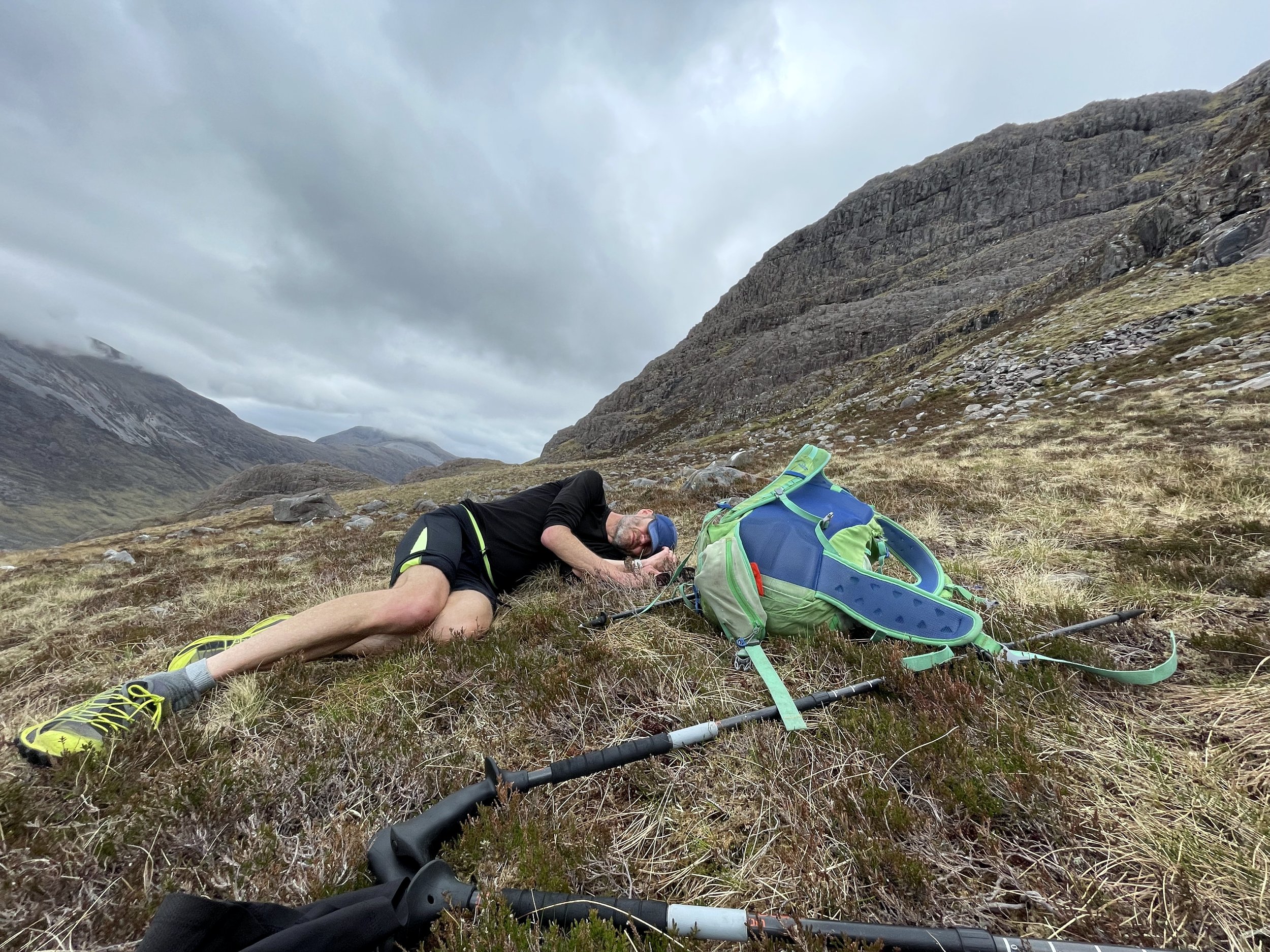
Tiredness swept across my mind in waves. The sound of John’s ceaseless hiccups had become like the ticking of some strange, broken clock that accompanied us throughout the night.
What had convinced me to join my friend John Fleetwood on a 72km link-up of almost every mountain in Torridon? The prospect of attempting a long, continuous round in the mountains had always fascinated me. The capacity to keep going for over 24 hours, without succumbing to tiredness or injury, seemed reserved for the super fit and the super hard. John’s route required 7,270 metres of ascent on rough, track-less ground; whilst tackling nine Munros; five Corbetts and eight scrambles. Despite having never run further than half a marathon across the bumpy hills of northern Leicestershire, I wanted to see how far I could get.
On the other hand, challenges like the one that faced us were in John’s blood. Over the past 20 years, he’d created and completed dozens of long rounds, many of them lasting for over 48 hours. I was reminded of John’s resilience during our drive northwards, when he told me about his attempt on the 74-mile Rigby Round across the Cairngorms one winter. Forty mph winds and freezing rain had enveloped him during the first night. His clothing and rucksack became encased in a layer of ice. The whiteout lasted for 40 hours, but somehow John plodded on through the deep snow. During the second night, he became hopelessly lost for nine hours. In his exhausted state, John became convinced that he was no longer walking alone.
“There was this other version of me,” he explained. “Their voice sounded totally emotionless, he’d just order me to keep moving and to keep my waterproof trousers on to avoid freezing.”
We drove to a point where our round would briefly intersect with the remote road from Kinlochewe. Amongst the gorse bushes we stashed a gas stove and some snacks. I wondered what state we’d be in if we ever managed to retrieve them during the following night. John pointed up at our planned descent from the ridges of Beinn Eighe: sheer screes, boulder fields and thick heather plummeted down for 850 metres and petered out at the road beside us. “Coming down that in the dark will be interesting,” John mused.
Above: ready to set off!
0hrs 0mins - Starting Out
At 11am we set off. John had been suffering from headaches and a lack of sleep during the previous few days, but this only appeared to mildly concern him as we made our first climb up onto the ridges of Liathach. The westward traverse along its five summits under sunny May skies floated by, and soon we had begun to jog back down to sea level.
During that knee-crunching descent from Liathach, it dawned on me just how fortress-like the mountains in Torridon were. Upon reaching the glen, we immediately set about re-ascending back up another 1,000 metres on steep, terraced slopes to tackle Beinn Alligin. I’d never visited Torridon before, but in six hours, we’d completed two of its most esteemed mountain traverses.
The ground underfoot was never straight forward. John pointed up towards the broken slopes of thick heather, boulders and crag bands on Beinn Dearg. The mountainside was routinely interrupted by near-vertical gullies that sliced down to the glen, and we had to scramble between them. From a distance it looked intimidating, but moving over the broken buttresses of Torridonian sandstone distracted us from our fatigue.
Above: On the descent from Liathach
8hrs 14mins - Scale sinking in
Standing on the top of Beinn Dearg after 7pm, it hit me that almost every hill surrounding us was on our route - even the most distant ones. In the end, I had to stop myself from looking. I’d already done more metres of ascent during the first quarter of our round than on any other day that I’d spent in the mountains. But somehow my legs felt okay, and John’s matter-of-fact attitude inspired belief in me that maybe this wasn’t such a big deal after all.
9hrs 11mins - The magic of the round
Charging down towards the next scramble, we were suddenly stopped in our tracks at the edge of a tiny lochan. With no-one else left out on the hills, the view back towards the northern corries of Liathach felt like a secret saved just for us. The mild evening air rippled across the glassy water. The evening sun cast shadows across a myriad of gullies and buttresses, revealing their endless complexities. Against a backdrop of fatigue and sustained effort, the view meant more. The magic of doing a long round began to reveal itself to me. Our journey would lead us into so many quiet spaces between the well-walked summits.
Above: Lochan beneath Liathach
10hrs 16mins - An unforgettable sunset
On the scramble up Sail Mhor, we emerged from the confines of a deep gully loaded with loose rock. The landscape behind us was transformed by the setting sun. Hundreds of tiny lochans shone back like glistening gems and the towers of Triple Buttress were cast fiery red. Concerns about our empty water bottles evaporated as we stood mesmerised by the transience of nature’s evening display.
Above: Sunset on Coinneach Mhor.
Above: A special sunset from Sail Mhor.
12hrs 44mins - Descent in darkness
At around midnight, we finally dropped off the ridges of Beinn Eighe, aiming for our food cache beside the road about 800 metres below. Frantic to find running water, the pathless descent over old snow patches and sheer scree slopes in total darkness wasn’t what either of us needed. John seemed to ski down the screes with the agility of a thirsty chamois. I initially struggled to keep up with his head torch beam but soon noticed that when I also ran, my feet stopped sinking beneath the quartzite stones. Just like the round itself, momentum was the secret key to forward progress. Our whoops of excitement echoed through the darkness as the road below gradually grew closer.
Above: Planning our off-trail descent from Beinn Eighe.
14hrs 50mins - A lay down in a lay-by
We finally stumbled upon our food cache in a sleepless stupor at 1:50am. John’s face lit up with glee in my head torch beam, as he cracked open the best tin of pears that either of us had ever tasted. We gorged on sandwiches and steaming coffee before taking an indulgent twenty minute lie-down in the lay-by. It had been our longest break so far, but I found it impossible to sleep. We had a long night ahead of us and I knew that if I stopped, then I’d never get back up.
16hrs 55mins - Over half-way
“Everything takes three times as long, just when you want it to take half as long” came John’s apt summary as we halted to catch our breath on the slog up to Sgurr Dubh. I peered up into the claggy pre-dawn darkness and hoped to see the climb petering out. It wasn’t. As exhausted as I felt, I struggled to imagine John’s level of discomfort. He’d been plagued by nausea and unrelenting hiccups for countless hours. On the top, we found ourselves perched above an ocean of cloud, with the rising sun casting crimson light across its swirling surface. The night was finally over and after 18 hours on the move, we were well over half way.
Above: Sunrise on Sgurr Dubh.
22hrs 40mins - Stopped by injury
Our plod over Sgorr nan Lochan Uaine and Beinn Liath Mhor went by in a misty haze. We leant heavily on our walking poles, each absorbed in our own silent worlds. Every now and then, we’d stop just to slump down in the heather for a moment and John’s body would shake with each unwelcome hiccup.
My dazed state was eventually halted by the jarring pains that had developed in my right knee during the night. Ibuprofen hadn’t helped, and so John gave me a knee brace for the out-and-back up Sgorr Ruadh. On our descent however, the pain worsened and I grimaced with each step. Fearful of an injury in such a remote place, I decided to bow out. John was understanding, and I hobbled off down a stalkers track towards the glen. I felt like I’d pushed my body as far as it could go. I tried to remind myself that our finish line was ultimately arbitrary. Not reaching it didn’t have to spoil the sense of achievement after having gotten so far. It just felt like a shame not to be finishing with John.
After twenty minutes of walking down the track, the pain in my knee had almost totally subsided. Unbelievable. The knee brace appeared to have worked its magic, and within half an hour, I’d climbed back up to find John. We were delighted to be reunited, and I continued with a new-found determination. Having ridden out yet another wave of discomfort, I started to believe that I could actually reach the end.
25hrs 30mins - Too tired to scramble
On the penultimate scramble up Maol Chean Dearg, John climbed ahead of me. His heavy limbs moved with all the prowess of someone who’d just drank twelve whiskies, and I was no faster. A handful of Munro-baggers on the summit stared in bemusement at our zombie-like state, but we were too knackered to explain.
29hrs 43mins - One last climb
As the afternoon ended, the final slog up Beinn Damph on trackless slopes loomed above us. It looked like the longest and steepest ascent of the whole round. We lay in the heather at the bottom and laughed at what we’d been reduced to. By the time we’d stumbled onto the summit, we couldn’t stand up for our celebratory photo. All that was left was the four kilometre descent back into Torridon.
Above: On the final summit of Beinn Damph!
32hrs 15mins - A strange apparition
The dreamy Caledonian forest embraced us with its trickling burns and sweet pine scents. We stumbled onto the last stretch of road, and I was confused to see a white cat rolling around in the grass beside us. John then pointed out that it was just a plastic bag blowing in the wind. I knew that I was knackered, but hallucinations were a whole new level.
33hrs 45mins - Sleep
At 8:40pm we collapsed into our tents, unable to form coherent sentences. When I got up the next morning, I couldn’t believe that my legs were still working. I felt so grateful for John’s guidance in helping me along my first ever big round. I think that I was able to finish because I’d accepted the possibility of failure from the very beginning. It helped me to focus on the next step rather than the finish line. The real challenge on a long round is in your head.
How to scramble safely in remote areas
Unlike well-travelled routes such as Crib Goch or Striding Edge, scrambling in remote areas has a real mountaineering flavour. The consequences of being benighted or caught out in bad weather on a remote scramble could be very serious.
There may be no phone signal or other people for many miles. It would also take much longer for mountain rescue to reach you should things go wrong. The longer walk-in’s (and walk-out’s) require strong levels of fitness, and setting out early is a must. It’s also often worth considering an overnight bivvy at the base of your route. This can allow you to tackle it in the morning with fresh legs and more hours of daylight ahead of you.
On less-travelled scrambles there likely won’t be any stone cairns; crampon scratches or polished rock from other peoples boots to hint at the correct way to go. Because of this, a solid base of route-finding experience on less serious scrambles is vital. Whilst planning, a detailed topo-guide and route description should be studied carefully before setting out, and also carried along with you.



